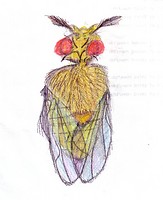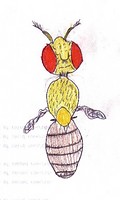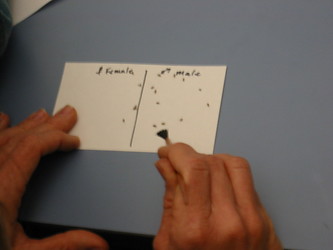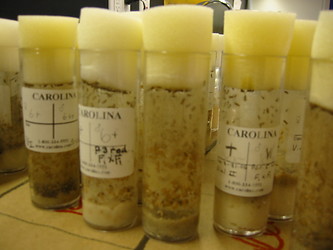Introduction
What is the purpose of this experiment?
There are 15 different types of fruit flies to study and breed together. Some flies have different wings, others have different eyes. Our group is studying the Vestigial type, which is a wing mutation and the other fruit flies in our group are wild winged. Before we started breeding them, we first had to find out how to recognize all the mutations and sexes. Once we learned this, we "fly napped them". When we sexed them all and separated them by their phenotypes, we put them in vials, vial 1 and 2. There was male vestigial and female wild in on vial and male wild and female vestigial in the other vial. We did this so both mutation and the wild-type can breed together. We then studied the outcomes of these two mutations. We began to learn about genetics and inheritance by seeing how our flies had autosomal traits because our flies' phenotypes proved to have nothing to do with the sex of the flies.
Why use fruit files?
Using fruit flies to study genetics and inheritance was easy because they're small and their bodies are easy to understand. When the two mutations started breeding, it was noticeable right away what the changes were. If a male wild was to mate with a female vestigial and an offspring came along, it would be an easy way to see what inheritance and gene it was carrying. Fruit flies are plain and simple when it comes to finding out sex and phenotypes. Watching them breed, hatch and grow from generation to generation has taught us about the way genetics work. It was an easy time to realize, study and most of all to learn off of fruit flies.They are small but very interesting and can give a lot of information. The basic reason we used fruit flies was because they're small, the changes were easy to see, they live about three weeks and that meant we wouldn't have these flies after we were done with our studies.
Fly Classification:
- Kingdom- Animalia
- Phylum- Arthropoda
- appendages, exoskeleton, segmented animals, cephaliztion, compounds eyes, open circulatory systems.
- Class - Insecta
- divided into 3 tagmata, more than 25 orders do not live in salt water, very short life span, produce large numbers of eggs.
- Order - Diptera
- 1 pair of wings, sucking piercing/lapping mouth parts.
- Genus - Drosophila
- Species - melanogaster
Phenotypes
In our fruit fly project, there were three different types of phenotypes: vestigial wings, wild type wings and eyes, and white-eyed flies. Flies with vestigial wings have wings that look like crinkled newspaper and are medium- sized lengthwise. Flies with wild type wings have wings that are flat and wide. Wild type eyes are red while other flies have white eyes. Our group is focusing on vestigial and wild type wings.




Group Life Cycle Log:
- Vial 1: Vg female- wild type male
- Vial 2: Vg male- wild type female
Vial 1 | Vial 2 |
| 3/16/06: 4 larva, flies are relatively calm, not moving around much | 3 flies don't move around much but the rest of them are moving |
| 3/17/06: The flakes at the bottom of the container is half gray at the top and half "clean". The files are crawling around. | Two files are not moving that much and the rest of the files are moving a lot. |
| 3/20/06: The flakes look really moldy and hard. I don't think there is any larva because it looks hard to grow larva in the moldy flakes. The files look tine; one is pregnant. We put some water in it right now.
| 2 files are dead. They're not as active as vial 1. |
| 3/21/06: We think we see one or 2 larvae all the files look good. | We think we see 1 larva the files are looking lazy and really not moving around. |
| 3/23/06: Many larvae and all the flies are crawling around at the top of the container; many pupae have appeared. | 3 of the flies are dead |
| 3/24/06: there are about 30- 40 pupae all crowded together around the middle of the tube wall. Some are lying on the yeast. | There are about 10 dark pupae in this vial. There are 2 dead flies. |
| 3/27/06: There are some flies that are ready to hatch; one already has. | No flies yet, same as last week. |
| 3/30/06: Incredibly crowded with flies (mostly wild type); flies are frantic! | Wild flies that are less crowded and has more pupae |
| 3/31/06: There are a lot of flies. | Not as many flies with still more pupae. |
| 4/3/06: Healthy flies, jumping around, 4 larvae | Healthy flies, moving everywhere, larvae are present |
| 4/6/06: Flies everywhere, larvae are present | Flies are at the top of the vial, larvae are in the middle of the vial |
| 4/17/06: Flies are healthy, a couple are dead at the bottom | Flies are gathered at the top of the vial |
| 4/21/06: There are only 4 flies, 1 vestigial female, 1 vestigial male, 1 wild female, 1 wild male. | There are very few vestigials. |
| 4/24/06: There are more active flies than in vial 2 and 13 vestigials. | There are less flies than in vial 1 and more wilds than vestigials. |
Sexing the flies:
The way that are group separated the flies was by the posterior end of the flies. The males' posterior end were dark and the females' posterion end were just a little dark but instead the posterior end were kind of a brown black color but lighter.
F1 Predictions:
If the mutation for vestigial (vg) is Dominant and wild (,) is recessive, then phenotype % will be 100% is vestigial (vg) and genotype % will be 100% is (vg,) heterozygous.
| vg | vg | |
| + | vg+ | vg+ |
| + | vg+ | vg+ |
If the wild (+) is Dominant and vestigial (vg) is recessive, then phenotype % will be 100% wild (+) and genotype % will be 100% wild.
| vg | vg | |
| +vg | +vg | |
| + | +vg | +vg |
If the mutation for vestigial (vg) is Sex-linked and Dominant and wild (,) is recessive,
mutation on female
| xvg | xvg | |
| x+ | xvgx+ | xvgx+ |
| y | xvgy | xvgy |
then phenotype% will be then genotype% will be
100% will be vg, 50% will 50% xvgy+ 50% xvgx+
be female, 50% male
mutation on male
| xvg | y | |
| x+ | xvgx+ | x+y |
| x+ | xvgx+ | x+y |
then phenotype% will be then genotype% will be
50% vg+ 50% wild, 50% xvgx+, 50% x+y
50% female, 50% male
If the wild (+) is Sex-linked and Dominant and the mutation for vestigial (vg) is recessive, then.....
mutation on female
| x+ | x+ | |
| xvg | x+xvg | x+xvg |
| y | x+y | x+y |
then phenotype% will be then genotype% will be
100% wild, 50% female, 50% x+xvg, 50% x,y
50% male
mutation on male
| x+ | y | |
| xvg | x+xvg | xvgy |
| xvg | x+xvg | xvgy |
then phenotype% will be then genotype% will be
50% wild, 50% vg 50% x+xvg, 50% xvgy
50% female, 50% male
F1 Offspring Outcomes
Vial 1: 100% Male wild and Female wild, ( Genotypes Males and Females heterozygous).
Vial 2: 100% Male wild and Female wild, ( Genotypes Males and Females heterozygous).
F2 Predictions:
(Vial 1) F1 Cross= female wild (genotype= +vg) X wild male (geno= +vg)
| vg | + | |
| vg | vgvg | vg+ |
| + | vg+ | ++ |
% Phenotype in F2 offspring: 75% wild, 25% vestigial
% Genotype in F2 offspring:
25% vgvg homozygous recessive
vg, 50% heterozygous
++ 25% homozygous dom.
(Vial 2) F1 Cross= female wild (genotype= ,vg) X wild male (geno= ,vg)
| + | vg | |
| + | ++ | +vg |
| vg | +vg | vgvg |
% Phenotype in F2 offspring:
75% wild, 25% vestigial
% Genotypes in F2 offspring:
50% heterozygous vg,
25% homozygous dom.
25% homozygous recessive
F2 Outcomes
Vial 1:
| Overall Total from Vial 1 | Wild Total | Vg Total |
| 388 | 252 | 136 vg |
Vial 2:
| Overall Total from Vial 2 | Wild Total | Vg Total |
| 227 | 209 | 18 vg |
Percent Error:
Vial 1:
| Phenotype | Observed | Expected | (O-E) | (O-E)/E | X100 | % Error |
| (t) | 262 | 298 | 89 | 0.2987 | 29.87 | 29.89% |
| (vg) | 136 | 99 | 37 | 0.3737 | 37.37 | 37.37% |
Vial 2:
| Phenotype | Observed | Expected | (o-E) | (O-E)/E | X100 | %Error |
| (t) | 209 | 170 | 39 | 0.229 | 22.29 | 22.29% |
| (vg) | 188 | 56 | 132 | 2.357 | 23.57 | 23.57% |
Conclusion:
If the mutation, vestigial wings, are recessive in the P generation, and wild wings are dominant, then by the F2 generation the expected phenotype ratio is 3:1. In the F2 outcomes the hypothesis is supported because vestigial wings proved to be recessive over wild wings in both vials. In vial 1, you can compare 37.37% vestigial to 29.89% wild. In vial 2, you can compare 23.57% vestigial to 22.29% wild.
One of the problems we had was with being unable to classify flies that had lost their wings in the transfer from the vial to the "sexing paper". We couldn't count them because of this, so we did not have an accurate number of the flies in the vials. Some flies would actually already be dead before the transfer for reasons we do not know. Because we do not know how these flies lost their wings or were already dead, we do not know how to fix this. Perhaps it was environmental problems but we cannot know for sure because we had done everything as we were supposed to. What would have happened if some of our flies had not died or lost their wings, what would the outcome had been? Why does it take longer for flies with mutations to appear out of the pupa?





 Go to quick links
Go to quick search
Go to navigation for this section of the ToL site
Go to detailed links for the ToL site
Go to quick links
Go to quick search
Go to navigation for this section of the ToL site
Go to detailed links for the ToL site